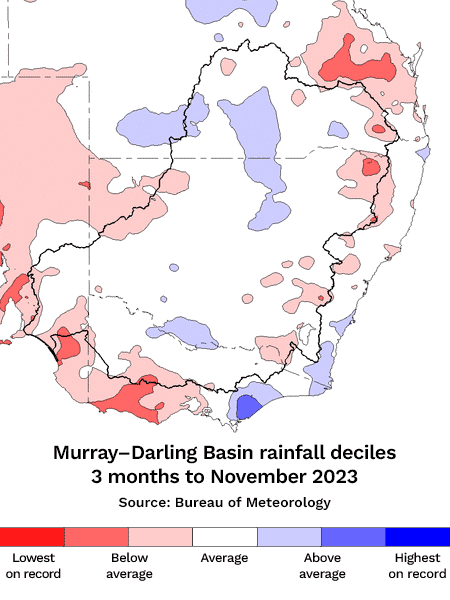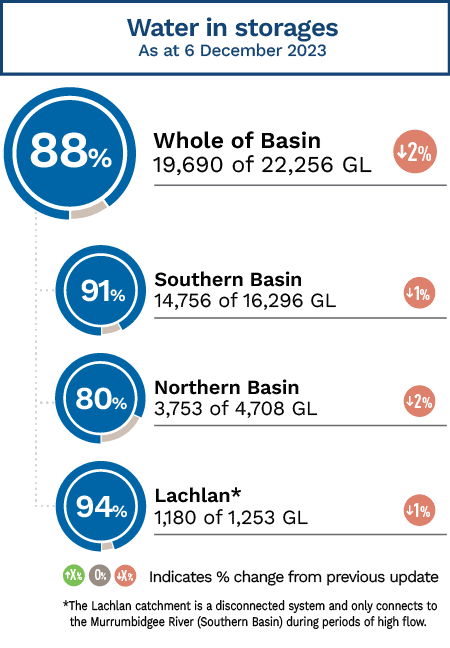- Higher rainfall in the Basin from October to November
- Dry and warm conditions are forecast as we move through summer
- The likelihood of water quality issues will increase with higher temperatures
- Conditions remain favourable for blue-green algae outbreaks

Drought
While November’s high rainfall improved the previous 3-month rainfall deciles considerably from October, spring rainfall was still 20.1% below the 1961–1990 average - the lowest for spring since 2019.
November rainfall was 37.8% above the 1961–1990 average for Australia, with large areas of the northern and southern Basin receiving above average rainfall.
Although soil moisture increased across most of Australia in November, average to below average soil moisture was still recorded across much of the southern Basin

Rainfall
Both the northern and southern Basins received average to above average rainfall for the month of November. This rainfall eased 4-month rainfall deficiencies in the east, however deficiencies continue in the south.
Areas of the northern Basin received highest on record rainfall for the month of November, including Southwood in the Borders Rivers catchment which recorded 239mm.
Wentworth, which sits at the confluence of the River Murray and Darling River recorded no rainfall for the month of November, while isolated areas of the Lower Darling and Paroo catchments received less than 25mm of rainfall.

Water storages and streamflow
At 22 November total storage in the Basin was 19,621 GL (88%), which is a slight decrease from last month. Both southern and northern Basin storages decreased by 2%, while the Lachlan catchment also decreased by 2%.
Flows within the River Murray system remain regulated with releases from storages meeting water orders throughout the system.
Releases from Hume Dam have included large volumes of water to meet a water order from environmental water holders, delivering water to the Barmah-Millewa forest and downstream along the River Murray into South Australia.
Water regulators through the Barmah–Millewa Forest remain open to accommodate higher upstream flows.
On the Darling (Baaka), releases continue from Menindee Lakes to deliver crucial Lower Darling Water for environmental purposes. It is possible that releases may increase in the coming weeks.
Directed released from Lake Victoria (Tar-Ru) on behalf of environmental water holders have now ceased, with flow to South Australia returning to regulated conditions.
Climate outlook
The Bureau’s long-range forecast into summer predicts below-median rainfall and above median maximum temperatures for much of the Basin.
The forecast is influenced by several factors, including El Niño and positive Indian Ocean Dipole events, and record warm oceans globally. These conditions are expected to continue through throughout summer.
There is an increased risk of bushfire throughout most of the northern Basin, and some areas of the southern Basin.

Water quality
The likelihood of water quality issues is rising as conditions become warmer. Basin rivers and storages are nutrient rich and conditions remain favourable for blue green algae outbreaks. In the lower Darling (Baaka) there is still a risk of low dissolved oxygen levels.
The Murray–Darling Basin Authority and state authorities monitor water quality conditions across the Basin year-round. For more information on water quality see the water quality page.
Summary of key water quality issues:
- Hypoxic blackwater: There are no current risks from hypoxic blackwater across the Basin.
- Low dissolved oxygen: : In the lower Darling (Baaka), dissolved oxygen levels generally remain near or above critical ecological thresholds. This risk will increase with prolonged hot and dry conditions.
- Blue-green algae: There is currently a risk of blue-green algae across most parts of the Murray–Darling Basin, particularly in New South Wales. For the latest information on blue-green algae alerts, contact the relevant state government contacts via the Getting information about current algal blooms page of our website.
- Elevated Salinity: Some areas of the central Darling River are seeing elevated salinity levels.
You can find all the latest news in our Newsroom or by following our socials: Facebook, X (Twitter), LinkedIn.